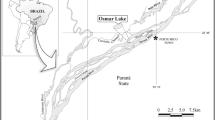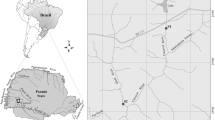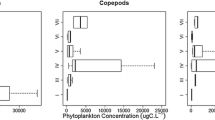Abstract
Phytoplankton functional classification based on simple morphological traits may simplify our understanding of variation in this community as a function of environmental filters. We tested the effectiveness of the morphology-based functional group (MBFG) approach as a model of phytoplankton temporal dynamics in a Brazilian subtropical river. The São João River has an area of approximately 79.10 km2, with 28.09 km2 located within the Iguaçu National Park, in Foz do Iguaçu, Paraná, Brazil. We collected phytoplankton samples and measured environmental variables in the intermediate river section on a monthly basis between August 2008 and July 2009. We tested for differences between the environmental variables, phytoplankton biovolume and sampled months and identified the environmental variables with the greatest influence on MBFGs. Our results revealed clear temporal variability of environmental conditions in this river. We recorded the presence of seven MBFGs (I, II, III, IV, V, VI and VII) in the lotic environment, with MBFG IV (chlorococcal chlorophyceans and desmids), V (flagellates) and VI (diatoms) being the most frequent and most important groups for phytoplankton biomass. Significant temporal differences were found for MBFGs I, II, IV, V and VI, with a clear seasonal succession, especially among MBFGs V and VI. Temperature, pH, electrical conductivity, transparency and nutrients were the main predictors of MBFGs in the São João River. Approaches based on traits have been increasingly applied in community ecology, and we believe that the MBFG approach can increase our understanding of environmental dynamics as well as improve the assessment of general ecological issues.




Similar content being viewed by others
References
Abonyi A, Leitão M, Stankovi I, Borics G, Várbíró G, Padisák J (2014) A large river (River Loire, France) survey to compare phytoplankton functional approaches: Do they display river zones in similar ways? Ecol Ind 46:11–22
American Public Health Association (1995) Standard methods for the examination of water and wastewater, 19th edn. APHA, Washington DC
Bicudo CEM, Menezes M (2006) Gêneros de Algas de Aguas Continentais do Brasil: Chave para identificação e descrições. RiMa, Sao Carlos
Bortolini JC, Bueno NC (2013) Seasonal variation of the phytoplankton community structure in the São João River, Iguaçu National Park, Brazil. Braz J Biol 73:1–14
Bortolini JC, Rodrigues LC, Train S (2014) Phytoplankton functional and morphological groups as indicators of environmental variability in a lateral channel of the Upper Paraná River floodplain. Acta Limnol Bras 26:98–108
Bortolini JC, Moresco GA, Paula ACM, Jati S, Rodrigues LC (2016) Functional approach based on morphology as a model of phytoplankton variability in a subtropical floodplain lake: a long-term study. Hydrobiologia 767:151–163
Chen N, Liu L, Li Y, Qiao D, Li Y, Zhang Y, Lv Y (2015) Morphology-based classification of functional groups for potamoplankton. J Limnol 74:559–571
Clarke KR (1993) Non-parametric multivariate analyses of changes in community structure. Aust Ecol 18:117–143
Dajoz R (2005) Princípios de Ecologia. Artmed, Porto Alegre
Descy JP, Darchambeau F, Lambert T, Stoyneva-Gaertner MP, Bouillon S, Borges AV (2017) Phytoplankton dynamics in the Congo River. Freshw Biol 62:87–101
Devercelli M (2006) Phytoplankton of the Middle Paraná River during an anomalous hydrological period: a morphological and functional approach. Hydrobiologia 563:465–478
Devercelli M, O’Farrell I (2013) Factors affecting the structure and maintenance of phytoplankton functional groups in a nutrient rich lowland river. Limnologica 43:67–78
Dokulil MT (2014) Potamoplankton and primary productivity in the River Danube. Hydrobiologia 729:209–227
El-otify AM, Iskaros IA (2015) Water quality and potamoplankton evaluation of the Nile River in Upper Egypt Qualidade da água e avaliação do potamoplâncton do rio Nilo no Alto Egito. Acta Limnol Bras 27:171–190
Heino J, Melo AS, Bini LM (2015) Reconceptualising the beta diversity-environmental heterogeneity relationship in running water systems. Freshw Biol 60:223–235
Heinze AW, Truesdale CL, Devaul SB, Swinden J, Sanders R (2013) Role of temperature in growth, feeding, and vertical distribution of the mixotrophic chrysophyte Dinobryon. Aquat Microb Ecol 71:155–163
Hu R, Han B, Naselli-Flores L (2013) Comparing biological classifications of freshwater phytoplankton: a case study from South China. Hydrobiologia 701:219–233
IBAMA (2008) Plano de manejo. Ministério do meio ambiente, Brasil. http://www.ibama.gov.br/siucweb/mostraUc.php?seqUc=17
Izaguirre I, Allende L, Escaray R, Bustingorry J, Pérez G, Tell G (2012) Comparison of morpho-functional phytoplankton classifications in human-impacted shallow lakes with different stable states. Hydrobiologia 698:203–216
Jones RI (2000) Mixotrophy in planktonic protists: an overview. Freshw Biol 45:219–226
Kruk C, Segura AM (2012) The habitat template of phytoplankton morphology-based functional groups. Hydrobiologia 698:191–202
Kruk C, Huszar VLM, Peeters EHM, Bonilla S, Costa L, Lurling M, Reynolds CS, Scheffer M (2010) A morphological classification capturing functional variation in phytoplankton. Freshw Biol 55:614–627
Kruk C, Peeters EHM, Van Nes EH, Huszar VLM, Costa LS, Scheffer M (2011) Phytoplankton community composition can be predicted best in terms of morphological groups. Limnol Oceanogr 56:110–118
Legendre P, Legendre L (1998) Numerical ecology. Elsevier, Amsterdam
Litchman E, Klausmeier CA (2008) Trait-based community ecology of phytoplankton. Annu Rev Ecol Evol Syst 39:615–639
Lund JWG, Kipling C, Lecren ED (1958) The inverted microscope method of estimating algal number and the statistical basis of estimating by counting. Hydrobiologia 11:980–985
Lürling M, Eshetu F, Faassen EJ, Kosten S, Huszar VLM (2013) Comparison of cyanobacterial and green algal growth rates at different temperatures. Freshw Biol 58:552–559
Manly BFG (1994) A primer of multivariate statistics. Chapmam & Hall, London
Mihaljević M, Špoljarić D, Stević F, Pfeiffer T (2013) Assessment of flood-induced changes of phytoplankton along a river–floodplain system using the morpho-functional approach. Environ Monit Assess 185:8601–8619
Mihaljević M, Stević F, Špoljarić D, Žuna T, Pfeiffer T (2015) Spatial pattern of phytoplankton based on the morphology-based functional approach along a river–floodplain gradient. River Res Appl 31:228–238
Naselli-Flores L, Padisák J (2016) Blowing in the wind: how many roads can a phytoplanktont walk down? A synthesis on phytoplankton biogeography and spatial processes. Hydrobiologia 764:303–313
O’Farreal IO, Izaguirre I, Vinocur A (1996) Phytoplankton ecology of the Lower Paraná River (Argentina). Arch Hidrobiol 1:75–89
Padisák J, Crossetti LO, Naselli-Flores L (2009) Use and m issue in the application of the phytoplankton functional classification: a critical review with updates. Hydrobiologia 621:1–19
R Development Core Team (2016) R: a language and environment for statistical computing. R Foundation for Statistical Computing, Vienna, Austria. http://www.R-project.org/
Reynolds CS (1994) The long, the short and the stalled: on the attributes of phytoplankton selected by physical mixing in lakes and rivers. Hydrobiologia 289:9–14
Reynolds CS (2006) Ecology of phytoplankton. Cambridge University Press, New York
Reynolds CS, Descy JP (1996) The production, biomass and structure of phytoplankton in large rivers. Archiv für Hydrobiologie 113:161–167
Reynolds CS, Huszar VLM, Kruk C, Naselli-Flores L, Melo S (2002) Towards a functional classification of the freshwater phytoplankton. J Plankton Res 24:417–428
Rodrigues L, Train S, Bovo-Scomparin VM, Jati S, Borsalli C, Marengoni E (2009) Interannual variability of phytoplankton in the main rivers of the Upper Paraná River floodplain, Brazil: influence of upstream reservoirs. Braz J Biol 69:501–516
Saad JF, Unrein F, Tribelli PM, López N, Izaguirre I (2016) Influence of lake trophic conditions on the dominant mixotrophic algal assemblages. J Plankton Res. doi:10.1093/plankt/fbw029
Salamuni R, Salamuni E, Rocha LA, Rocha AL (2002) Parque Nacional do Iguaçu, PR: Cataratas de fama mundial. In: Schobbenhaus C, Campos DA, Queiroz ET, Winge M, Berbert-Born MLC (eds) Sítios Geológicos e Paleontológicos do Brasil. Comissão Brasileira de Sítios Geológicos e Paleobiológicos (SIGEP), Brasília, pp 313–321
Salmaso N, Padisák J (2007) Morpho-functional groups and phytoplankton development in two deep lakes (Lake Garda, Italy and Lake Stechlin, Germany). Hydrobiologia 578:97–112
Salmaso N, Naselli-Flores L, Padisák J (2015) Functional classifications and their application in phytoplankton ecology. Freshw Biol 60:603–619
Serra T, Granata T, Colomer J, Stips A, Møhlenberg F, Casamitjana X (2003) The role of advection and turbulent mixing in the vertical distribution of phytoplankton. Estuar Coast Shelf Sci 56:53–62
Statisoft Inc. (2005) Statistica (data analysis software system) version 7.1. www.statisoft.inc
Sun J, Liu D (2003) Geometric models for calculating cell biovolume and surface area for phytoplankton. J Plankton Res 25:1331–1346
Török P, T-Krasznai E, B-Beres V, Bácsi I, Borics G, Tóthmérész B (2016) Functional diversity supports the biomass–diversity humped-back relationship in phytoplankton assemblages. Funct Ecol. doi:10.1111/1365-2435.12631
Train S, Rodrigues LC (1998) Temporal fluctuations of the phytoplankton community of the Baía River, in the upper Paraná River floodplain, Mato Grosso do Sul, Brazil. Hydrobiologia 361:125–134
Utermöhl H (1958) Zur Vervollkommnung der quantitativen phytoplankton-methodic. Verhandlungen der Internationalen Vereinigung fu¨r Theoretische und Angewandte Limnologie 9:1–39
Vannote RL, Minshall GW, Cummins KW, Sedell JR, Cushin CE (1980) The river continuum concept. Can J Fish Aquat Sci 37:130–137
Zalocar De Domitrovic Y (2002) Structure and variation of the Paraguay River phytoplankton in two periods of its hydrological cycle. Hydrobiologia 472:177–196
Zalocar De Domitrovic Y, Poi De Neiff ASG, Casco SL (2007) Abundance and diversity of phytoplankton in the Paraná River (Argentina) 220 km downstream of the Yacyretá reservoir. Braz J Biol 67:53–63
Acknowledgements
The authors thank the Brazilian Instituto Chico Mendes de Conservação da Biodiversidade (ICMBio, Chico Mendes Institute for the Conservation of Biodiversity) for providing the necessary research permits, as well as the staff of Iguaçu National Park, for the use of the facilities to complete these studies and Sisbio for the permission to carry out the research in the protected area (13134-2). NCB is grateful to the CNPq of Brazil for a Research Productivity Grant (process 307196/2013-5). JCB is grateful to the CNPq for providing post-doctoral scholarship (process 165796/2015-4).
Author information
Authors and Affiliations
Corresponding author
Rights and permissions
About this article
Cite this article
Bortolini, J.C., Bueno, N.C. Temporal dynamics of phytoplankton using the morphology-based functional approach in a subtropical river. Braz. J. Bot 40, 741–748 (2017). https://doi.org/10.1007/s40415-017-0385-0
Received:
Accepted:
Published:
Issue Date:
DOI: https://doi.org/10.1007/s40415-017-0385-0




